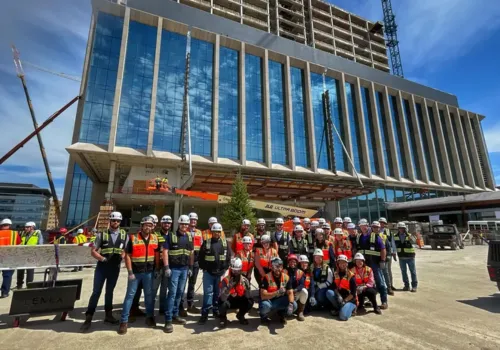
Contractors nationwide continue to grapple with a familiar and persistent issue: a significant labor shortage that threatens productivity and delays project timelines. But as the industry evolves, some companies are finding effective, long-term solutions — and it all starts with how they train, support, and retain their workforce.
Today’s most forward-thinking contractors are investing in structured, scalable training programs that go far beyond orientation. These efforts not only help new workers get started but also foster continuous development and long-term career growth.
One of the most common reasons new entrants leave the construction field is the lack of a clear path forward. To combat this, top-performing contractors are intentionally mapping out career paths with defined roles, responsibilities, and training milestones.

“Many new entrants to the field don’t know what comes after their first job.”
“Leading contractors map out clear career paths with defined roles and training tied to each step. When employees see how training leads to advancement, they are more likely to stay engaged and commit to a future with their company.”
By showing workers where their careers could lead — and what steps are necessary to get there — these companies are giving employees compelling reasons to stay and grow.
Effective training must reflect what actually happens in the field. That’s why top contractors rely on curricula developed by seasoned professionals who understand the realities of the jobsite.
“Good training reflects the realities of the jobsite. The most trusted programs use curriculum developed and regularly reviewed by professionals with years of field experience.”
“Their insight ensures content is accurate, relevant and aligned with real jobsite demands. Contractors that implement expert-informed training programs get craft professionals who meet the performance standards required to meet heavy jobsite demands.”
This alignment between instruction and day-to-day job expectations helps close the skills gap more efficiently — and builds trust between trainers and workers.
While classroom hours are essential, demonstrated ability is key. The most effective programs measure performance in real-world tasks, not just theory or attendance.
“Classroom hours alone cannot build a skilled workforce. The most effective training programs require workers to demonstrate they can do the job.”
“A performance-based approach reduces rework, improves productivity and shortens the time it takes to get workers fully competent. It holds training accountable to real-world outcomes.”
Tracking and analyzing the results of these programs is just as important. Industry leaders use data to guide improvements and demonstrate return on investment.
“And tracking those outcomes is an extra step that’s worth it. Contractors leading in workforce development are looking at metrics like certifications earned, skills demonstrated, promotions made and retention rates. That data helps improve programs and prove ROI.”
Effective training doesn’t stop at the jobsite. It starts long before a worker’s first day — in high schools, community colleges, and workforce organizations. Top contractors know that building a collaborative talent pipeline is crucial to long-term success.
“Workforce development must be a collaborative effort among stakeholders. Successful contractors form partnerships with secondary and post-secondary schools and community organizations to identify talent and broaden awareness of the potential of a career in the trades.”
“By creating meaningful alignment, they cultivate local talent pipelines that connect more people to opportunities in the field and open doors for individuals to start meaningful careers in construction.”
The National Center for Construction Education and Research (NCCER) plays a leading role in shaping this training landscape. As a nonprofit education foundation, NCCER offers standardized, flexible programs that align directly with jobsite needs.
“Its programs offer flexible, standardized learning built to meet real jobsite needs.”
Rather than seek temporary answers to a complex problem, today’s top contractors are committing to sustainable, measurable workforce development that drives long-term success.
“Contractors who want to help solve the labor shortage are leveling up their training efforts. They’re not looking for quick fixes, they’re creating sustainable programs that attract and retain the talent necessary to build better projects.”
For companies looking to make a lasting impact on their workforce and the future of the industry, the blueprint is already there — clear career pathways, real-world training, measurable results, and collaborative recruitment.
More information is available at nccer.org.
Originally reported by National Center For Construction Education And Research in Construction Dive.